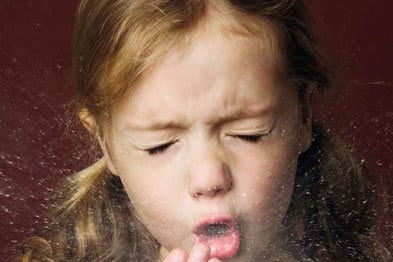By Moshe Heller and Stephen Cowan
Moshe: O. is a very curious 2-year-old that came to see me after she was diagnosed with whooping cough (pertussis). O. started to show signs of illness during a trip abroad when she developed a runny nose for a few days and then sores appeared in her mouth, which her pediatrician diagnosed as Coxsackie. No treatment was given and O. seemed to be recovering, but then she started experiencing bouts of increasingly severe coughing. O.’s mother described the cough as very “barky”, and when she brought her back to the pediatrician, he suspected this was croup and gave an over-the-counter cough syrup. The cough persisted as increasingly discrete paroxysms, which would occur mostly at night. Although she returned to the pediatrician a few times she was told that it was viral and would pass. A few days before coming back to the U.S., she visited a different pediatrician, who suspected that O. had whooping cough and recommended testing her for confirmation. Upon returning to the U.S., O.’s mother called her pediatrician, who ordered the nasopharyngeal swab that was positive for pertussis. O. was given antibiotics immediately. Her mother was told that it was too late to change the course of illness, though it would prevent the disease from spreading.
Steve: This is a fairly typical story of how a child gets diagnosed with pertussis (whooping cough). Let me just review the story a bit here. Most illnesses in children are viral and so it would not be uncommon for a pediatrician to suspect Coxsackie (a common late summer-damp heat disease) in kids associated with blisters on the gums, though it typically presents with middle burner symptoms of poor appetite, diarrhea, or vomiting. It’s more typical in the summer months, and though rare it can cause respiratory symptoms. Whooping cough typically starts with a prodrome of mild runny nose without fever. Some kids have no presenting symptoms during this stage. This usually lasts 1-2 weeks and then, as in this case, the cough becomes increasingly dramatic. It is not uncommon for it to be mistaken for croup, another common childhood illness caused by a number of viruses, most commonly one of the parainfluenza strains. One of the interesting ways I have found in clinical practice to differentiate possible whooping cough from croup is that steam treatments will help croup but aggravate the cough of whooping cough. An important point to keep in mind is that during this initial mild stage of whooping cough, it can be fatal in very young babies, causing them to stop breathing after a bout of cough or even without the cough (apnea). This is one of the primary reasons that the vaccine was originally developed. In O.’s case, she had not received any vaccines at that point, which perhaps should have raised a red flag for the pediatrician. Nevertheless, it is common for doctors to overlook whooping cough because it is not very common nowadays.
Moshe: Exactly! I’m not sure I would have thought of pertussis if O.’s parents hadn’t told me about the diagnosis. Her parents brought her to see me a few days after returning to the U.S. She was still having bouts of cough, mostly at night, and it sounded dry and barky. Her mother complained that she was very moody and cranky and not acting like herself. Her appetite was reduced but bowel movements were normal. When I examined her, I first noticed that her eyes were glazed as if she was having a fever, but her temperature was normal. I also noticed that her finger vein was dark and passed the wind gate and the tip of her tongue was red. On palpation, I found her lymph glands to be swollen, especially the sub-mandibular but also sub-occipital nodes. Lung auscultation revealed crackles bilaterally. O. is a very small child and seemed a bit fragile to me, although she is very inquisitive and affectionate. At first she was a bit suspicious, but warmed to me quickly and I was able to examine her as well as treat her.
Steve: Many children do not develop the characteristic “whoop” of whooping cough, especially these days, because most children who get whooping cough have been immunized against pertussis via the DTaP vaccine. In fact, in the most recent pertussis outbreak in a Florida preschool this past year, all children had received at least 3 doses of pertussis vaccine, and in one class where half the students came down with whooping cough, all 17 kids had received the full series of vaccines to pertussis. This has led a number of physicians to begin questioning the efficacy of the modern, acellular pertussis vaccine.
If you think a career in holistic medicine is something you would like to pursue, contact us and speak to an admissions representative to get started on your new journey!
Moshe: I’d like to review some of her clinical findings:
-Glazed look in the eyes – this is a very common sign of a lingering pathogenic factor. It is important to notice the eyes look a bit glittery but there is no actual fever.
-Examination of the finger vein – This process helps in the diagnosis of pathogenic factors. In particular when we see a dark vein that passes the wind gate this indicates that heat is starting to injure the qi.
-Red tip tongue – this confirmed the presence of heat.
-Palpating the lymph glands – enlarged lymph glands are a sign that damp has congealed to phlegm and indicate the presence of an LPF.
-Lung crackles – I use the lung sounds to help in the diagnosis of the pathology and crackles indicate the presence of phlegm in the lung.
It was clear to me that O. had a lingering pathogenic factor (LPF) of phlegm and heat.
Steve: In China, pertussis has classically been called “the cough that lasts a hundred days”. Now a 3-week cough is one thing, but a 3-month cough is another, especially a cough that is forceful enough to break ribs! I have seen the cough linger even longer and sometimes come back during later colds if it is not completely resolved. Though whooping cough is not fatal in older children, such a prolonged course of illness can severely disrupt sleep for the whole family. It is also highly contagious for both adults and children and, most importantly, it can further compromise the child’s immune system, causing secondary infections like pneumonia. Western medicine offers very little at this stage other than antibiotic treatment, which does nothing to shorten the course though it may limit the spread. It has been my experience that this is a perfect situation for the application of Chinese medicine that aims at releasing and resolving the lingering pathogenic factor and shortening the course of illness.
Moshe: In cases like O.’s, TCM practitioners aim to help the body clear the LPF and strengthen the protective qi in order to prevent reoccurrence. I began treating O. with Shoni-Shin technique to improve the flow of qi in the channels as well as prepare her for needling. I performed tapping and scraping on both yang and yin channels of the hands, feet, back, and chest. The points I used included: Lung 7 to help regulate the lung qi, Large Intestine 11 and Du 14 to help clear heat, Spleen 9 and Stomach 40 to help transform phlegm, and Urinary Bladder 13 to strengthen the lung qi. I also prescribed herbs – a combination of Bao He Wan, to support her digestion, with Qing Qi Hua Tan tang to clear phlegm and heat. I sent her home with magnets on Lung 7 dispersing, Large Intestine 11 dispersing, Ding Chuan dispersing and Urinary Bladder 13 tonification. I also taught the mother how to apply tapping massage before bed.
O. returned for a follow up treatment 5 days later and her mother reported that although the cough was not cleared, it was significantly reduced. I continued to treat O. for another three treatments until the cough was no longer an issue.
Steve: Chinese medicine has evolved over centuries. Western medicine, by contrast is a relatively young therapy. One of the advantages of Chinese medicine’s long time to ripen is that it offers a number of different approaches to understanding and treating the disease process. For example, Western medicine offers very little in the treatment of early (wei stage) viral illnesses, whereas Chinese medicine has developed a number of effective therapies for releasing pathogens before they get caught in deeper levels of the body. Such therapeutics could only come about from centuries of carefully tracking the ways we get sick and get better.
In my practice of pediatrics, I often explain to children and their parents that the lung is a highly righteous organ, concerned with protecting the delicate holy ground of the alveoli where air (da qi) gets exchanged with things we need to let go of. The lung is prone to strong reactions when it has been insulted and tends to hold on to things in its protective zeal. Chinese medicine teaches that dryness insults the lung. I find that artificial air and heat in homes, schools, and particularly in air travel, as in the case of O., is one of the leading causes of the increasing lung pathology we are seeing in developing countries. When the terrain is allowed to dry out, a pathogen like pertussis, which typically lives in harmony with other bacteria in most of our noses, will gain a foothold. As initial wei-phlegm defenses dry out, they lose their effectiveness, allowing the bacteria to enter the qi-level, causing a dry violent paroxysmal cough; a perfect representation of the lung’s righteousness. In pediatrics, it is always important to remember that the spleen is central to the process of acquiring qi. Two caveats I often advise parents in treating LPF in children: 1) pay attention to diet—avoid feeding uncooked foods during illness so that the body does not have to muster further metabolic heat to break down food, which will take resources away from wei-immune defense, and 2) promote the release of phlegm by increasing bowel movements. This is one of the most effective ways the body has for getting rid of lingering phlegm-heat, provided of course the child is adequately hydrated throughout the process. In fact, in treating any respiratory phlegm condition in kids, I often tell parents that when the stools get loose, the cough will resolve within the week. In constipated children, sometimes we will see the body try to get the heat out through the skin as eczema, a connection to the lung/large intestine network, long recognized for centuries by Chinese medicine but often overlooked by Western medicine.
Moshe’s approach in this case perfectly illustrates our job as conductor rather than dictator in comforting the lung to let go of the lingering pathogenic factor. His gentleness is designed to match the child’s tender yin state. His attention to the spleen (prescribing Bao He Wan) and his collaboration in teaching O.’s mother serves to empower holistic healing. This case demonstrates the important contribution Chinese medicine offers in providing healthcare to children.
Reprinted with permission from the FSOMA Journal, Summer 2016.
Stephen Cowan, MD, is the author of Fire Child Water Child, on how understanding the five types of ADHD can help you improve your child’s self-esteem and attention. He is a board-certified pediatrician with over 25 years of clinical experience working with children. He has a subspecialty in developmental pediatrics and is a fellow in the American Academy of Pediatrics, serving as a member of the section on developmental disabilities. He is a clinical instructor at NY Medical College and a member of the American Academy of Medical Acupuncture. He founded and practices at the Westchester Center for Holistic Families and also sees patients in NYC at Tournesol Wellness.
Featured Posts:

